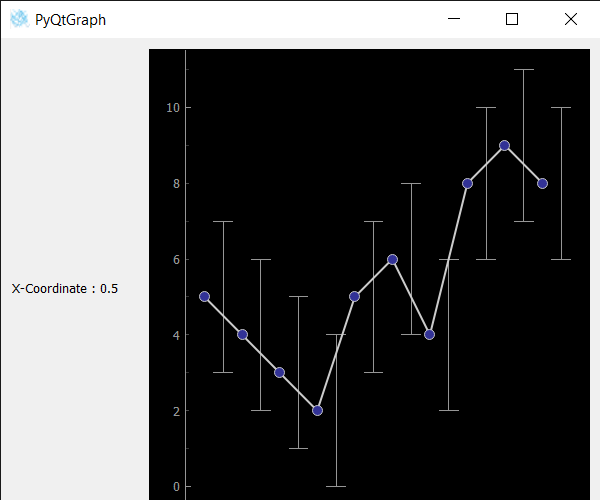En este artículo, veremos cómo podemos obtener un valor de coordenadas del gráfico de barras de error en el módulo PyQtGraph. PyQtGraph es una biblioteca de interfaz de usuario y gráficos para Python que proporciona la funcionalidad comúnmente requerida en el diseño y las aplicaciones científicas. Sus objetivos principales son proporcionar gráficos rápidos e interactivos para mostrar datos (gráficos, videos, etc.). Las barras de error son representaciones gráficas de la variabilidad de los datos y se utilizan en gráficos para indicar el error o la incertidumbre en una medición informada. Dan una idea general de cuán precisa es una medición o, por el contrario, qué tan lejos del valor informado podría estar el valor real. El valor de la coordenada del gráfico de barras de error es la coordenada x, y se puede configurar con la ayuda del método setX y setY.
Podemos crear una ventana de trazado y crear un gráfico de barras de error en ella con la ayuda de los comandos que se indican a continuación.
# creating a pyqtgraph plot window
plt = pg.plot()
# creating a error bar item object
error = pg.ErrorBarItem(x=x, y=y, top=top,
bottom=bottom, beam=0.5)
Para hacer esto, usamos el método x e y con el objeto del elemento de la barra de error
Sintaxis: error.x() y error.y()
Argumento: no toma ningún argumento
Retorno: devuelve el valor flotante
A continuación se muestra la implementación.
Python3
# importing Qt widgets
from PyQt5.QtWidgets import *
# importing system
import sys
# importing numpy as np
import numpy as np
# importing pyqtgraph as pg
import pyqtgraph as pg
from PyQt5.QtGui import *
from PyQt5.QtCore import *
from collections import namedtuple
class Window(QMainWindow):
def __init__(self):
super().__init__()
# setting title
self.setWindowTitle("PyQtGraph")
# setting geometry
self.setGeometry(100, 100, 600, 500)
# icon
icon = QIcon("skin.png")
# setting icon to the window
self.setWindowIcon(icon)
# calling method
self.UiComponents()
# showing all the widgets
self.show()
# method for components
def UiComponents(self):
# creating a widget object
widget = QWidget()
# creating a label
label = QLabel("Geeksforgeeks Error Bar plot")
# setting minimum width
label.setMinimumWidth(130)
# making label do word wrap
label.setWordWrap(True)
# setting configuration options
pg.setConfigOptions(antialias=True)
# creating x-axis values
x = np.array([1, 2, 3, 4, 5, 6, 7, 8, 9, 10])
# creating y-axis values
y = np.array([5, 4, 3, 2, 5, 6, 4, 8, 9, 8])
# creating upper bound values
top = np.array([2, 2, 2, 2, 2, 2, 2, 2, 2, 2])
# creating lower bound values
bottom = np.array([2, 2, 2, 2, 2, 2, 2, 2, 2, 2])
# creating a plot window
plt = pg.plot()
# creating a error bar item
error = pg.ErrorBarItem(beam=0.5)
# setting data to error bar item
error.setData(x=x, y=y, top=top, bottom=bottom)
# adding error bar item to the plot window
plt.addItem(error)
# plotting the data on plot window
plt.plot(x, y, symbol='o', pen={'color': 0.8, 'width': 2})
# Creating a grid layout
layout = QGridLayout()
# minimum width value of the label
label.setMinimumWidth(130)
# setting this layout to the widget
widget.setLayout(layout)
# adding label in the layout
layout.addWidget(label, 1, 0)
# plot window goes on right side, spanning 3 rows
layout.addWidget(plt, 0, 1, 3, 1)
# setting this widget as central widget of the main window
self.setCentralWidget(widget)
error.setX(0.5)
# getting x-co-ordinate of error bar item
value = error.x()
# setting text to the label
label.setText("X-Coordinate : " + str(value))
# create pyqt5 app
App = QApplication(sys.argv)
# create the instance of our Window
window = Window()
# start the app
sys.exit(App.exec())
Producción :

Publicación traducida automáticamente
Artículo escrito por rakshitarora y traducido por Barcelona Geeks. The original can be accessed here. Licence: CCBY-SA